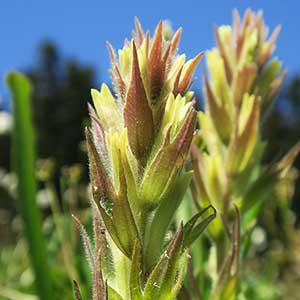Castilleja cryptantha
Castilleja thompsonii
Mt. Rainier or obscure paintbrush, obscure Indian paintbrush, obscure paintbrush
Thompson's Indian paintbrush, Thompson's owl clover, Thompson's paintbrush
few to several, erect or ascending, unbranched, hairs spreading, long, soft, eglandular, mixed with short stipitate-glandular ones.
few to many, erect or ascending, unbranched or branched, hairs spreading, long, stiff, sometimes soft (especially in higher elevations), eglandular, mixed with shorter stipitate-glandular ones.
green, often with brown or purple veins, narrowly to broadly lanceolate, 1.5–4 cm, not fleshy, margins plane, ± involute, 0–3-lobed, apex acute to acuminate;
lobes spreading-ascending, narrowly lanceolate, apex acute to ± obtuse.
green to purple or reddish brown, linear to narrowly oblong or linear-lanceolate, 1.4–7.4 cm, not fleshy, margins plane to ± wavy, involute or flat, 3(–7)-lobed, apex acuminate;
lobes spreading-ascending, linear, short to long moving up leaf axis, apex acute or obtuse.
(2.5–)3–6 × 1–2 cm; green to dull brown or dull reddish purple throughout, or proximally green to dull brown or dull reddish purple, distally yellow on apices, broadly lanceolate to ovate, (0–)3-lobed;
lobes ascending, narrowly lanceolate, long or short, arising near mid length, apex acute or acuminate.
2.5–14 × 1–4 cm;
bracts greenish to pale yellow or reddish brown throughout, or proximally greenish to dull reddish purple, or ruddy brown, distally greenish to yellow-green or yellow, often aging dull reddish to dull purplish, lanceolate to oblong to ovate, 3–5(–9)-lobed;
lobes spreading to ascending, linear to narrowly lanceolate, long, proximal lobes arising below mid length, apex acute to obtuse.
straight, 14–16 mm;
tube 11–14 mm;
whole corolla included within calyx;
beak adaxially pale yellow, 1–2 mm;
abaxial lip deep green, slightly inflated, 4–5 mm, 67% as long as beak;
teeth ascending, pale, 1.5–2 mm.
straight, 18–21 mm;
tube 11–16 mm; subequal to calyx, sometimes beak exserted;
beak adaxially green, 5–7(–8) mm;
abaxial lip white, often proximally reddish, prominent, scarcely expanded, ± cylindric, 2.5–4(–5) mm, 50–70% as long as beak, glabrous or obscurely puberulent;
teeth incurved to erect, white, 2.5 mm.
proximally green or pale with green veins, lobes yellow, sometimes becoming deep red with age, 12–15 mm;
abaxial and adaxial clefts 3–7 mm, 25–50% of calyx length, deeper than laterals, lateral 1–3(–4) mm, 8–20% of calyx length;
lobes triangular, adaxial segments longer than abaxials, apex acute or obtuse.
colored as bracts, 12–25 mm;
abaxial and adaxial clefts 4–8 mm, 20–60% of calyx length, deeper than laterals, lateral (0–)1–3 mm, 7–25% of calyx length;
lobes linear, lanceolate, or triangular, apex acute, sometimes obtuse.
= 24.
= 24, 48.
Castilleja cryptantha
Castilleja thompsonii
Castilleja cryptantha is endemic to the vicinity of Mt. Rainier in the Cascade Range, with most populations found within Mt. Rainier National Park. Unlike most species of Castilleja, it is apparently self-pollinating (W. J. Duffield 1972); the small flowers are entirely enclosed within the yellowish calyces, which tend to grow deep reddish as they age. The purplish brown bracts are also unusual in the genus.
(Discussion copyrighted by Flora of North America; reprinted with permission.)
Castilleja thompsonii is a characteristic species of the sagebrush communities on the eastern slope of the Cascade Range in Washington, and in the high deserts of the Columbia Basin. Historically, its range approached but apparently never entered Idaho in the Spokane River valley, but much of its habitat in that area is now converted to agriculture or suburban development or overwhelmed by non-native, invasive plants. Castilleja thompsonii occurs in a few sites in the Okanogan Valley region of southern British Columbia and at one site on the eastern slopes of the Cascade Range in Wasco County, Oregon. A distinctive form from the subalpine and alpine zones of Mt. Adams, in the southern Cascade Range of Washington, was named C. villicaulis. This form may merit varietal status under C. thompsonii. While both names were described in the same paper, C. thompsonii is the name used in all regional floras since their publication, after C. villicaulis was reduced to synonymy by M. Ownbey (1959).
(Discussion copyrighted by Flora of North America; reprinted with permission.)


